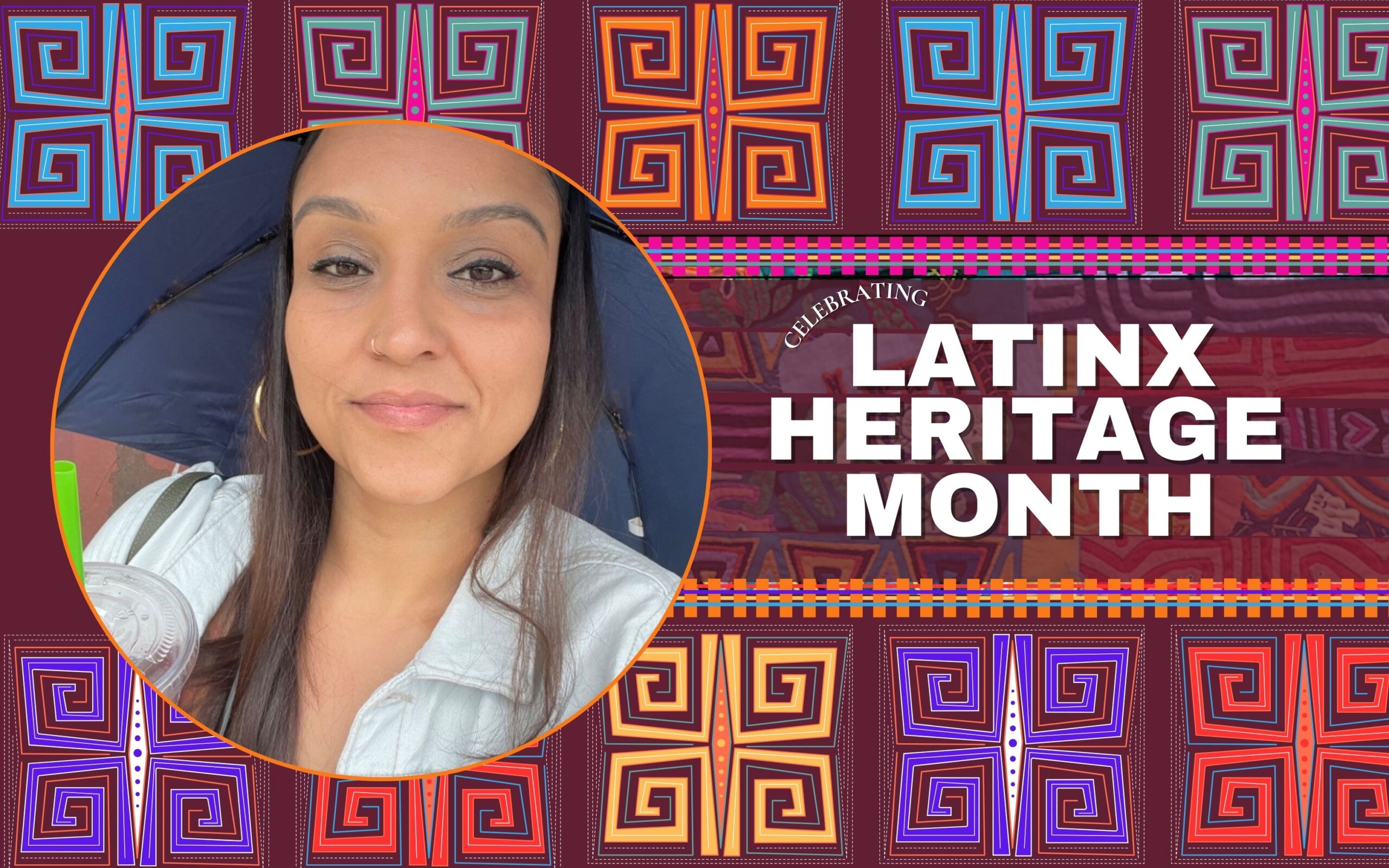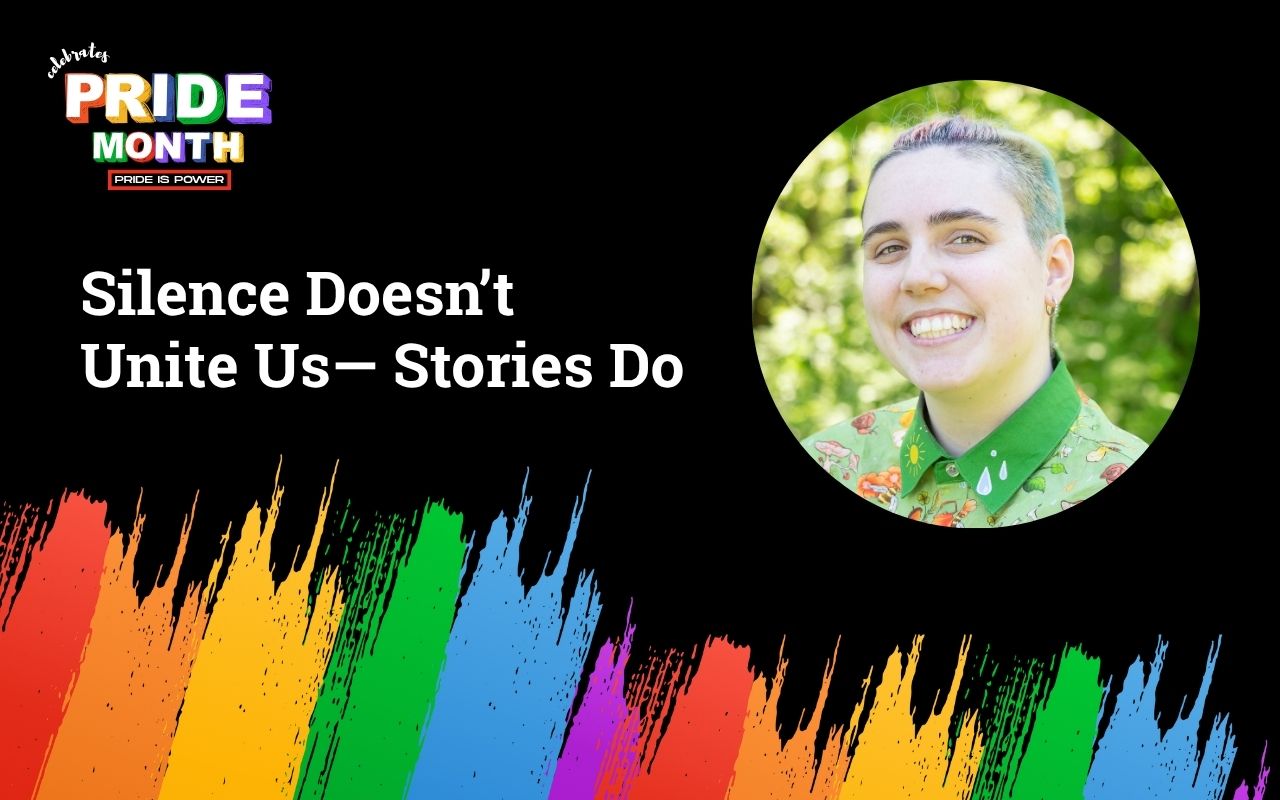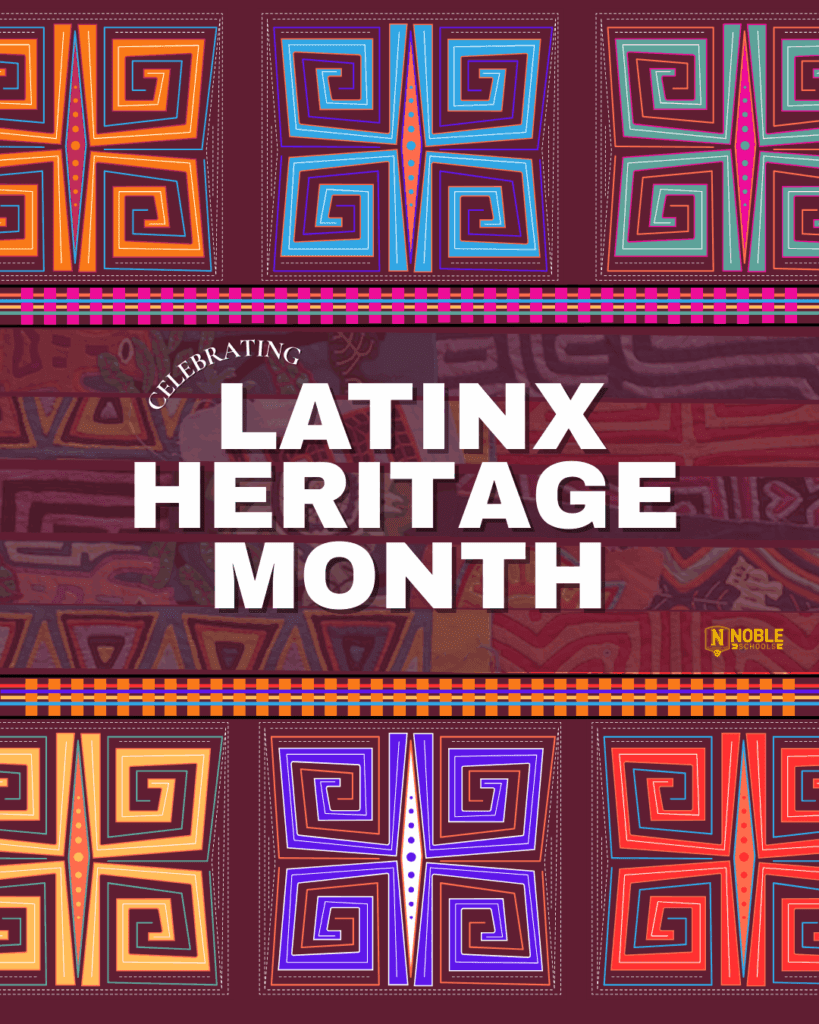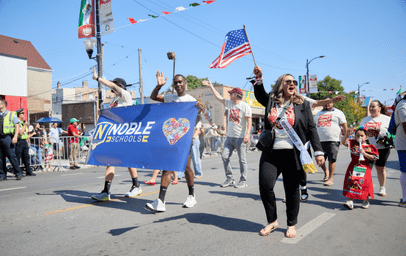
This is part of a series of writings from Noble staff that celebrate heritage and history. This piece was written to celebrate Latinx Heritage Month in 2025. Click here for more information about the usage of the phrase No Me Quiero Ir de Aqui.
By Tatiana Ramos | she/her
Assistant Dean of Culture, Muchin College Prep
As a member of Noble’s first graduating class, my journey at Noble started at my elementary school in the Humboldt Park neighborhood, where I was recruited to attend a “first of its kind” high school that would soon be opening just a few blocks down the boulevard from my house. I had always been a high-performing student, and although I had been accepted to several selective schools around the city, the promises of small class sizes and proximity to my house sparked my interest. This would become one of the most important decisions I would ever make.
Noble embraced me and created a home away from home, where I was able to explore my passions, develop lifelong friendships, and find my footing as an educator, surrounded by and encouraged by people who looked like me!
My Boricua heritage has shaped me, my value system, and ultimately my calling to educate.
My heritage is not merely part of my past—it’s a dynamic energy that influences my vision for tomorrow. The island’s history of celebration, pride, and fearlessness in the face of inequity, poverty, and oppression is embedded in the core of my soul in ways that I am honored to showcase through my personality, actions, and desire to educate young people of color at Noble.
I saw how access and representation affected my own community, and I came to understand at a young age that knowledge is not simply power—it’s liberation.
Liberation: the recurring theme in the plight of Latinos since … (Acho!)
Throughout U.S. history, state power has often been wielded to suppress the voices, identities, and movements of marginalized communities. Two examples—though separated by time and context—reveal how law and enforcement have been used as tools of control: La Ley de la Mordaza (the Gag Law) in Puerto Rico (1948–1957) and Immigration and Customs Enforcement (ICE) raids targeting undocumented communities in the contemporary United States.
At their core, both the Gag Law and ICE raids function as mechanisms of political and social repression, particularly aimed at people of color who are viewed as threats to the dominant power structure.
The Gag Law criminalized the public expression of Puerto Rican identity and aspirations for independence. Merely owning a Puerto Rican flag, singing nationalist songs, or advocating for self-determination could result in imprisonment or fines. The law created an atmosphere of fear and surveillance, discouraging open dialogue and silencing political dissent.
Similarly, ICE raids instill fear in immigrant communities—especially Latinx communities—by targeting undocumented individuals in homes, workplaces, and public spaces. These raids disrupt families, lead to mass detentions and deportations, and create an environment of constant anxiety. Like the Gag Law, ICE actions often serve not just to enforce policy, but to suppress identity, silence advocacy, and deter organizing within immigrant communities.
Both systems criminalize people not for violence or wrongdoing, but for who they are and what they represent. In the case of the Gag Law, being openly Puerto Rican and proud of one’s culture—especially when tied to independence—was considered subversive. In the case of ICE raids, simply existing in the U.S. without documentation, regardless of one’s community contributions or personal history, is treated as a criminal act.
This criminalization delegitimizes the humanity of the targeted group and reinforces racist and xenophobic narratives. Both cases demonstrate how the state can redefine legality to suppress specific populations.
Despite these oppressive conditions, both Puerto Ricans under the Gag Law and immigrants facing ICE raids have responded with powerful acts of resistance and resilience. During the Gag Law era, individuals risked their lives to fly the Puerto Rican flag and maintain their culture. Nationalist uprisings, such as the Jayuya Revolt, were bold assertions of self-determination.
In the face of ICE, undocumented individuals and allies have created sanctuary spaces, organized community defense networks, and protested publicly. Movements like #AbolishICE echo the spirit of Puerto Rican resistance, calling not only for the end of harmful practices but also for the reimagining of a just, inclusive society.
While separated by decades and different legal frameworks, the Gag Law and ICE raids reflect a shared legacy of state repression against communities of color in the U.S. empire. Both demonstrate how governments have used fear and criminalization to silence identity and activism—but also how those same tools have sparked resilience, solidarity, and a continued fight for justice.
Understanding these parallels helps us recognize that the struggle for civil rights, dignity, and self-determination is ongoing—and deeply interconnected across time and geography.
As a Puerto Rican Boricua, I carry with me a legacy of resilience that was built through colonization, migration, and resistance. That legacy demands that I create spaces where students of color are seen, heard, and empowered.
In Chicago, where racial and economic disparities continue to impact educational achievement, I am passionately dedicated to lending my voice and identity to bridging the gap. My heritage ties me to something greater than myself, and it serves as a daily reminder of why representation matters within our classrooms.
By becoming a Noble educator, I honor my past and invest in the possibilities of those who share my story—students whose promise must be nurtured, not neglected.
No Me Quiero Ir de Aquí: Aceptando mi herencia como educadora boricua y orgullosa exalumna de Noble
Por Tatiana Ramos | she/her/ella
Vicedecano de Cultura, Muchin College Prep
Como miembro de la primera clase de Noble, mi trayectoria en Noble comenzó en mi escuela primaria del barrio de Humboldt Park, donde me seleccionaron para asistir a una escuela secundaria “pionera en su género” que pronto abriría sus puertas a pocas cuadras de mi casa. Siempre había sido una estudiante de alto rendimiento y, aunque me habían aceptado en varias escuelas selectivas de la ciudad, la promesa de clases reducidas y la proximidad a mi casa despertaron mi interés. Esta sería una de las decisiones más importantes que tomaría en mi vida.
Noble me acogió y creó un hogar lejos de casa, donde pude explorar mis pasiones, desarrollar amistades para toda la vida y encontrar mi lugar como educadora, rodeada y animada por personas que se parecían a mí.
Mi herencia boricua me ha moldeado, mi sistema de valores y, en última instancia, mi vocación por la educación.
Mi herencia no es solo parte de mi pasado, es una energía dinámica que influye en mi visión del futuro. La historia de celebración, orgullo y valentía de la isla frente a la desigualdad, la pobreza y la opresión está arraigada en lo más profundo de mi alma, y me siento honrada de poder mostrarla a través de mi personalidad, mis acciones y mi deseo de educar a los jóvenes de color en Noble.
Vi cómo el acceso y la representación afectaban a mi propia comunidad y desde muy joven comprendí que el tener una educación no es simplemente de tener poder, sino de liberación.
Liberación: el tema recurrente en la lucha de los latinos desde… (¡Acho!)
A lo largo de la historia de Estados Unidos, el poder estatal se ha ejercido a menudo para reprimir las voces, las identidades y los movimientos de las comunidades marginadas. Dos ejemplos, aunque separados por el tiempo y el contexto, revelan cómo se han utilizado la ley y la aplicación de la ley como herramientas de control: La Ley de la Mordaza (la Ley Mordaza) en Puerto Rico (1948-1957) y las redadas del Servicio de Inmigración y Control de Aduanas (ICE) dirigidas a las comunidades indocumentadas en los Estados Unidos contemporáneos.
En esencia, tanto la Ley Mordaza como las redadas del ICE funcionan como mecanismos de represión política y social, dirigidos especialmente a las personas de color que se consideran una amenaza para la estructura de poder dominante.
La Ley Mordaza penalizaba la expresión pública de la identidad puertorriqueña y las aspiraciones de independencia. El simple hecho de poseer una bandera puertorriqueña, cantar canciones nacionalistas o defender la autodeterminación podía acarrear penas de prisión o multas. La ley creó un clima de miedo y vigilancia, que desalentaba el diálogo abierto y silenciaba la disidencia política.
Del mismo modo, las redadas del ICE infunden miedo en las comunidades de inmigrantes, especialmente en las comunidades latinas, al perseguir a personas indocumentadas en sus hogares, lugares de trabajo y espacios públicos. Estas redadas desestabilizan a las familias, provocan detenciones y deportaciones masivas y crean un ambiente de ansiedad constante. Al igual que la Ley Mordaza, las acciones del ICE a menudo no solo sirven para hacer cumplir la política, sino también para suprimir la identidad, silenciar la defensa de los derechos y disuadir la organización dentro de las comunidades de inmigrantes.
Ambos sistemas criminalizan a las personas no por su violencia o sus actos ilícitos, sino por lo que son y lo que representan. En el caso de la Ley Mordaza, ser abiertamente puertorriqueño y estar orgulloso de la propia cultura —especialmente cuando se vincula con la independencia— se consideraba subversivo. En el caso de las redadas del ICE, el simple hecho de estar en Estados Unidos sin documentación, independientemente de las contribuciones a la comunidad o la historia personal de cada uno, se considera un acto delictivo.
Esta criminalización deslegitima la humanidad del grupo y refuerza las narrativas racistas y xenófobas. Ambos casos demuestran cómo el país puede redefinir la legalidad para reprimir a poblaciones específicas.
A pesar de estas condiciones opresivas, tanto los puertorriqueños bajo la Ley Mordaza como los inmigrantes que se enfrentan a las redadas del ICE han respondido con poderosos actos de resistencia y resiliencia. Durante la era de la Ley Mordaza, las personas arriesgaron sus vidas para enarbolar la bandera puertorriqueña y mantener su cultura. Los levantamientos nacionalistas, como la Revuelta de Jayuya, fueron audaces afirmaciones de autodeterminación.
Ante ICE, las personas indocumentadas y sus aliados han creado espacios de refugio, organizado redes de defensa comunitaria y protestado públicamente. Movimientos como #AbolishICE se hacen eco del espíritu de resistencia puertorriqueño, pidiendo no solo el fin de las prácticas perjudiciales, sino también la reinvención de una sociedad justa e inclusiva.
Aunque separadas por décadas y marcos legales diferentes, la Ley Mordaza y las redadas de ICE reflejan un legado compartido de represión estatal contra las comunidades de color en el imperio estadounidense. Ambas demuestran cómo los gobiernos han utilizado el miedo y la criminalización para silenciar la identidad y el activismo, pero también cómo esas mismas herramientas han despertado la resiliencia, la solidaridad y una lucha continua por la justicia.
Comprender estos paralelismos nos ayuda a reconocer que la lucha por los derechos civiles, la dignidad y la autodeterminación es continua y está profundamente interconectada a lo largo del tiempo y el espacio.
Como boricua puertorriqueña, llevo conmigo un legado de resiliencia forjado a través de la colonización, la migración y la resistencia. Ese legado me exige crear espacios en los que los estudiantes de color se vean vistos, escuchados y empoderados.
En Chicago, donde las disparidades raciales y económicas siguen afectando al rendimiento educativo, me dedico con pasión a prestar mi voz y mi identidad para cerrar la brecha que existe. Mi herencia me une a algo más grande que yo misma y me sirve como recordatorio diario de por qué la representación es importante en nuestras aulas.
Al convertirme en educadora de Noble, honro mi pasado e invierto en las posibilidades de aquellos que comparten mi historia: estudiantes cuya promesa debe ser cultivada, no descuidada.
《我不想离开这里》:作为波多黎各裔教育工作者与诺布尔高中骄傲
By Tatiana Ramos | she/her
穆钦预科学校文化事务助理院长
作为诺布尔高中首届毕业生,
诺布尔学校给予我温暖的归属感,成为我的第二个家。在这里,
波多黎各血脉塑造了我的价值观体系,最终指引我投身教育事业。
这份血脉不仅承载着过往,更是塑造未来愿景的蓬勃力量。
我亲眼目睹机会与代表性如何影响我的社区,年少时便领悟到:
解放:自……以来拉丁裔困境中的永恒主题(阿乔!)
纵观美国历史,国家权力常被用于压制边缘群体的发声、
本质上,《封口法》与ICE突袭行动都是政治与社会压迫的机制,
《封口法》将公开表达波多黎各身份认同与独立诉求定为犯罪。
同样,移民与海关执法局的突袭行动通过在住宅、
这两套体系将人定罪的依据并非暴力或不当行为,
这种刑事化剥夺了目标群体的人性尊严,
尽管面临如此压迫,无论是遭受《禁言法》压制的波多黎各人,
面对移民海关执法局,无证移民及其盟友创建庇护空间、
尽管相隔数十年且法律框架迥异,
理解这些相似性有助于我们认识到:争取民权、
作为波多黎各人,我肩负着在殖民、迁徙与抗争中铸就的坚韧传承。
在芝加哥这座种族与经济鸿沟持续影响教育成就的城市,
成为Noble教育工作者,既是对过往的致敬,







